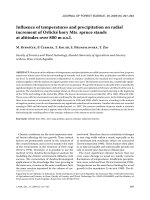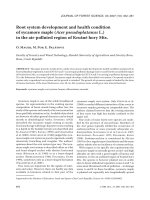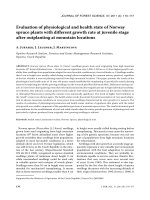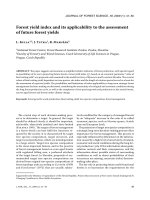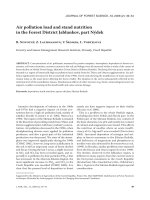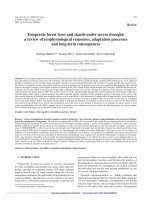Báo cáo lâm nghiệp: "Stratifying, partially redrying and storing Douglas-fir seeds effects on growth and physiology during germination" doc
Bạn đang xem bản rút gọn của tài liệu. Xem và tải ngay bản đầy đủ của tài liệu tại đây (1.08 MB, 13 trang )
Stratifying,
partially
redrying
and
storing
Douglas-fir
seeds :
effects
on
growth
and
physiology
during
germination
*
Marlene
DE
MATOS
MALAVASI,
and
D.P.
LAVEN
Susan
G.
STAFFORD
ER
D.P.
LAVENDER
tment
of
Forest
Science,
Department
of
Forest
Science,
Oregon
State
University,
Corvcrtlis,
OR
97331,
U.S.A.
Summary
Douglas-fir
[Psea!dotsuga
menziesii
(Mirb.)
Franco]
seeds
collected
from
a
coastal
and
an
interior
source
in
Oregon
were
stratified
at
45
p.
100
moisture
content
(MC)
and
then
redried
(to
35
or
25
p.
la0
MC)
and/or
stored
(for
1
or
3
months)
so
that
the
complex
interactions
among
stratification,
redrying,
and
storage
and
their
impacts
on
seed
vigor
and
resultant
seedling
growth
could
be
investigated.
Stratified
whole
seeds
and
seed
parts
were
hydrated
to
different
degrees.
Redrying
stratified
seeds
to
35
p.
100
MC
did
not
affect
MC
of
embryos
or
gametophytes,
but
redrying
to
25
p.
100
MC
reduced
MC
of
all
seed
structures.
Three
months
of
storage
did
not
alter
moisture
distribution
within
seeds.
Stratification
reduced
the
germination
percentage
of
interior-source
seeds
but
hastened
germination
speed
for
seeds
from
both
sources.
Redrying
stratified
seeds
to
35
and
25
p.
100
MC
increased
seed
vigor
and
seedling
length
and
dry
weight
remarkably,
a
response
similar
to
the
«
invigorating
effect
»
reported
to
improve
seed
performance
for
other
types
of
plants.
Storing
stratified
seeds,
without
redrying
them,
for
1
or
3
months
generally
reduced
seed
vigor,
as
reflected
by
germination
speed
and
seedling
length
and
dry
weight,
yet
redried
seeds
stored
no
better
than
nondried.
Levels
of
biochemical
compounds
studied
werc
strongly
correlated
with
germination
speed.
Results
suggest
that
it
would
be
advantageous
to
redry
seeds
to
a
range
of
25
to
35
p.
100
MC
directly
before
sowing
to
produce
vigorous
seedlings
or
allow
expression
of
stratification
benefits.
1.
Introduction
Stratification
treatment
(moist
chilling)
is
a
commonly
used
technique
for
over-
coming
dormancy
in
seeds
of
many
temperate-zone
species.
However,
practical
problems
arise
in
connection
with
storing
stratified
seeds
when
unfavorable
weather
during
the
sowing
season
makes
it
difficult
to
synchronize
the
end
of
stratification
with
the
desired
sowing
date.
In
addition,
preserving
surplus
stratified
seeds
creates
a
related
problem
because
lengthening
the
stratification
period
may
cause
seed
loss
through
pregermination
or
deterioration.
F.R.L.
1895,
Forest
Research
Laboratory,
Oregon
State
University,
Corvallis,
OR
97331,
U.S.A.
Findings
of
workers
studying
redrying
and
storage
of
stratified
forest-tree
seeds
have
been
inconsistent.
B
ARNETT
(1972)
reported
that
stratified
loblolly
pine
(Pinus
taeda
L.)
seeds
could
be
safely
stored
at
1 &dquo;C
for
12
months
after
redrying
to
10
p.
100
moisture
content
without
reducing
total
germination
percentage ;
however,
this
procedure
reinduced
dormancy,
necessitating
restratification.
Comparing
germi-
nation
of
stratified
Douglas-fir
[Pseudotsuga
menziesii
(Mirb.)
Franco]
seeds
redried
for
3
weeks
with
that
of
nondried
stratified
and
nonstratified
seeds,
H
EDDE
ttwteK
i(1968)
noted
that
air
drying
did
not
adversely
affect
seed
viability
but,
like
BARNLT!r
’(1972),
that
the
benefits
of
stratification
were
lost
and
seeds
had
to
be
restratified.
In
contrast,
A!Lr!t
(1962)
found
that
even
prolonged
storage
of
stratified
Douglas-
fir
seeds
redried
to
about
10
p.
100
moisture
content
rarely
offset
the
stratification
effect
completely
and had
little
if
any
effect
upon
germinative
capacity
where
seed
quality
was
high.
VnNLSSE
(1967)
reported
no
adverse
effect
on
seed
viability
of
.stratified
Douglas-fir
seeds
redried
to
a
moisture
content
below
7
p.
100,
noting
that
these
seeds
could
be
safely
stored
at
5
OC
for
«
several
weeks
» before
sowing.
;DnNIELSON
&
T
ANAKA
(1978)
stratified,
air
dried,
and
stored
(at
2 &dquo;C)
seeds
from
,ponderosa
pine
(Pi
h
us
ponderosa
Dougl.
ex
Laws.)
and
Douglas-fir
seed
lots.
The
,redried
ponderosa
pine
seeds
(moisture
content
of
approximately
26
p.
100)
could
,be
stored
for
9
months
without
losing
their
viability
or
stratification
benefits ;
however,
germination
of
the
redried
Douglas-fir
seeds
declined
about
40
p.
100,
probably
due
to
their
higher
moisture
content
(approximately
37
p.
100)
during
storage.
Later,
E
DWARDS
(1981)
found
that
stratified
A6ies
seeds
redried
to
approxi-
mately
25
p.
100
moisture
content
could
be
stored
for
up
to
12
months
without
losing
their
viability
or
the
benefits
of
stratification
and,
further,
that
redrying
stratified
seeds
stimulated
germination
to
much
higher
levels
than
stratification
alone.
We
conducted
the
research
reported
here
and
in
the
companion
paper
(Strati-
fying,
Redrying,
and
Storing
Douglas-fir
Seeds :
Biochemical
Responses,
DE
M
ATOS
M.a
L
nvnst
et
al.,
1985)
to
study
further
the
physiological
effects
of
stratification
on
Douglas-fir
seeds
and
the
possible
expression
of
those
effects
during
germination.
In
this
aspect
of
the
study,
we
investigated
the
complex
interactions
among
stratification
and
subsequent
redrying
and
storage
and
their
impacts
on
seed
vigor
and
seedling
growth.
Further,
because
no
published
data
relate
moisture
content
of
the
whole
seed
to
that
of
its
parts
(embryo,
gametophyte
tissue,
seed
coat),
we
examined
those
relationships
as
well.
Germination
involves
the
physiology
of
living
tissues
in
gametophyte
and
cmbryo ;
however,
the
seed
coat,
which
makes
up
about
40
p.
100
of
the
seed
weight,
is
essentially
dead.
To
meaningfully
relate
moisture
content
to
germination,
then,
requires
that
the
moisture
content
of
tissues
involved
in
germi-
nation
be
known.
2.
Materials
and
Methods
Two
Douglas-fir
seed
lots
with
high
germinative
capacity
were
obtained
from
a
commercial
seed
company.
Seeds
in
both
lots
had
been
collected
in
1980
in
Oregon,
,one
lot
from
coastal
seed
zone
061
(elevation
0-500
ft),
the
other
from
interior
seed
zone
252
(elevation
501-1
000
ft).
Seeds
were
stored
for
4
months
in
airtight
containers
at
1 °C,
then,
before
experimentation,
screened
to
obtain
large,
uniform
size.
Screened
seeds
of
both
lots
[average
moisture
content
(MC)
of
7
p.
100]
were
stored
at
1
&dquo;C
over
the
2-year
duration
of
the
experiment.
2.1.
Gen<?n!
procedure
Seeds
were
soaked
in
water
at
room
temperature
for
24
hours,
drained,
placed
in
4-mil
polyethylene
bags,
and
then
stratified
at
3
°C
for
28
days
at
45
p.
100
MC.
MC
of
some
stratified
seeds
was
adjusted
downward
to
35
or
25
p.
100
by
redrying
,seeds
in
a
single
layer
on
a
mesh
screen
in
a
standard
room
(21
&dquo;C
temperature,
70
p.
100
relative
humidity)
for
20
minutes
or
48
hours,
respectively.
Most
redried
(35
or
25
p.
100
MC)
and
nondried
(45
p.
100
MC)
seeds
were
then
placed
in
dry
4-mil
polyethylene
bags
and
returned
to
cold
storage
at
3
°C
for
1
or
3
months ;
the
rest
were
not
stored.
In
total,
seeds
from
the
original
sample
(7
p.
100
MC)
and
seeds
at
three
MCs
(45,
35,
and
25
p.
100),
stored for
two
periods
(1
and
3
months)
or
not
stored
at
all,
composed
the
10
treatments
(table
1 ),
and
effects
of
redrying-
and
storage
on
whole
seeds
and
seed
parts,
seed
vigor,
and
seedling
growth
were
assessed
under
the
various
treatment
conditions.
To
attain
the
target
MCs
(35
or
25
p.
100)
for
redrying,
100
seeds
from
each
lot
(10
replications
of
10
seeds
each)
were
air
dried
inside
the
standard
room
previously
described
( 1)
every
5
minutes
up
to
1
hour,
(2)
every
1 /2
hour
up
to
2
hours,
(3)
every
hour
up
to
12
hours,
and
(4)
every
12
hours
up
to
48
hours.
Mean
MC,
expressed
as a
percentage
of
seed
fresh
weight,
was
calculated
by
oven-
drying
four
samples
of
10
seeds
each
for
24
hours
at
105 &dquo;C :
fresh
weight
-
drv
weight
These
means
were
used
as
the basis
for
determining
how
long
seeds
should
dry
to
attain
the
target
MCs.
The
MC
of
seed
parts-embryo,
gametophyte
tissue,
and
seed
coat-was
determined
by
dissecting
four
replications
of
10
seeds
of
each
of
the
nine
stratification
treatments
inside
a
cold
room
(3
&dquo;C)
at
90
p.
100
relative
humidity.
Nonstratified
seeds
(NS)
were
dissected
inside
a
hot
room
(33 &dquo;C)
at
32
p.
100
relative
humidity.
MC
was
again
expressed
as
a
percentage
of
fresh
weight
and
calculated
by
the
oven-drying
method
previously
described.
Four
hundred
treated
seeds
(four
replications
of
100
seeds
each)
were
germinated
in
clear,
covered
plastic
dishes
containing
200
ml
of
sterilized
peat
moss
and
vermi-
culite
and
15
ml
of
water.
Temperature
alternated
daily
between
30 °C
for
8
hours
and
20 °C
for
16
hours ;
illumination
with
cool-white
fluorescent
lights
(1 000
lux)
accompanied
the
higher
temperature
period.
Seeds
were
considered
germinated
when
their
radicles
were
at
least
2
mm
long.
Germinants
were
counted
every
second
day,
up
to
28
days.
An
index
of
seed
vigor,
expressed
as
germination
speed,
was
then
calculated :
’l1aíBt&dquo;
no
(T
P1’rn1n
!H1
tc
{fl14ct
{&dquo;lI1IntB
nA
n:Ç>!,., ,.;n<:JntL’
11
r
}C’t
0
&dquo;
’1
1’ntB
Length
and
dry
weight
of
40
seedlings
(four
replications
of
10
seedlings
each)
from
the
germination
test
samples
were
recorded
5
days
after
radicles
emerged.
Length
(in
millimeters)
was
measured
as
seedling
extension
from
the
tip
of
the
radicle
to
the
top
of
the
cotyledons,
weight
by
oven-drying
seedlings
at
70 &dquo;C
until
constant
weight
was
attained.
Levels
of
certain
biochemical
compounds
also
were
correlated
with
seed
vigor
and
seedling
growth.
Because
biochemical
response
was
felt
to
be
an
intrinsic
phenomenon,
not
a
treatment-induced
effect,
we
pooled
all
observations
from
the
10
treatments,
two
seed
sources,
and
three
replications,
for
a
total
of
60.
Growth
analyses
are
presented
here ;
details
of
the
experimental
methodology
and
results
of
the
biochemical
analyses
are
reported
fully
in
the
companion
paper
(D
E
M
ATOS
M
ALAVASI
et
al.,
1985).
2.2.
Statistical
analysis
Initially,
analysis
of
variance
for
a
completely
randomized
design
was
conducted
on
all
data
to
assess
significant
treatment
effects.
Then
t-tests
were
used
to
determine
which
treatment
means
were
significantly
different
at
the
5
p.
100
probability
level
(P
<
0.05).
Regressions
were
run
on
the
biochemical
data.
Dependent
variables
for
growth
response
-
total
germination
(GERM),
germination
speed
(SPEED),
total
germinant
length
(LENGTH),
and
germinant
dry
weight
(DRWT) -
were
first
regresscd
indi-
vidually
against
the
biochemical
variables
-
adenosine
triphosphate
(ATP),
total
adenosine
phosphates
(TAP),
deoxyribonucleic
acid
(DNA),
ribonucleic acid
(RNA),
nucleotides
(NUC),
and
energy
charge
(EC).
Stepwise
multiple
regressions
were
then
fitted
for
these
same
variables.
DNA
was
the
first
variable
entered
for
all
dependent
variables
except
GERM
because
it
was
the
most
highly
correlated
with
almost
all
the
dependent
variables ;
for
GERM,
RNA
was
the
first
and
only
variable
entered.
Multiple
regressions
also
were
run
on
the
data
grouped
by
storage
treatment.
Canonical
correlation,
a
multivariate
analysis
technique
assessing
the
degree
of
relation-
ship
between
two
sets
of
variables
(HARRIS,
1975),
was
used
to
determine
any
relationships
between
biochemical
and
growth
variables
not
previously
identified
by
regression.
3.
Results
3.1.
MC
of
whole
seeds
and
seed
parts
Each
of
the
seed
components
hydrates
to
a
different
extent
during
stratification
(table
2).
MC
of
stratified
whole
seeds,
seed
coats,
embryos,
and
gametophytes
was,
respectively,
7,
13,
11,
and
6
times
greater
than
that
of
nonstratified
whole
seeds
and
seed
parts.
Redrying
stratified
seeds
from
45
to
35
p.
100
MC
did
not
alter
MC
of
the
embryo
and
gametophyte
but
significantly
reduced
that
of the
seed
coat
(table
3),
On
the
other
hand,
redrying
stratified
seed
from
45
to
25
p.
100
MC
significantly
reduced
MC
in
all
seed
structures.
Generally,
3
months
of
storage
did
not
affect
MC
of
whole
seeds
or
seed
parts
(table
4) ;
the
exception
was
seed
coat
MC
in
nondried
stratified
seeds
stored
for
3
months
(S 3),
which
apparently
was
reduced.
3.2.
Growth
response
3.21.
Germination
and
seed
vigor
Germination
percentages
of
the
nondried
stratified
controls
(SO,
S1,
S3)
ftom
both
sources
were
significantly
reduced
by
3
months
of
storage
(fig.
1
A,
C).
However,
redrying
stratified
seeds
generally
did
not
affect
germination
percentages
regardless
of
storage
period.
The
exceptions
were
coastal-source
seeds
redried
to
35
p.
100
MC
and
stored
for
1
month
(S1D1),
which
had
poorer
germination,
and
interior-source
seeds
redried
to
25
p.
100
MC
and
stored
for
3
months
(S3D2),
which
had
better
germination,
than
the
respective
controls
(Sl,
S3).
Nonstratified
controls
(NS)
had
better
germination
than
stratified
controls
(SO)
for
the
interior
source
(fig.
1
C).
Seed
vigor
of
nondried
stratified
controls
(SO,
Sl,
S3)
from
the
coastal
source
(fig.
1
B)
progressively
decreased
as
storage
length
increased,
but
that
of
interior-
source
seed
was
reduced
only
by
3
months
of
storage
(S3 ;
fig.
1
D).
However,
average
vigor
significantly
increased
when
nondried
controls
(SO)
from
the
coastal
source
were
redried
to
35
p.
100
MC
(SOD1).
Seeds
from
the
interior
source
behaved
similarly ;
in
addition,
redrying
to
25
p.
100
MC
(SOD2)
effectively
increased
seed
vigor.
For
both
sources,
stratified
seeds
(SO)
were
more
vigorous
than
nonstratified
(NS ;
fig.
1
B,
D).
3.22.
Seedling
length
and
dry
weight
Seedlings
produced
from
nondried
stratified
controls
(SO,
Sl,
S3)
for
both
seed
sources
were
progressively
shorter
as
storage
length
increased
(fig.
2
A,
C).
Seedlings
originating
from
coastal-source
seeds
redried
to
25
p.
100
MC
(SOD2,
S1D2,
S3D2)
were
significantly
longer
than
controls
at
all storage
periods ;
those
redried
to
35
p.
100
MC
and
stored
for
3
months
(S3D1)
also
were
longer
than
the
controls
(S3).
Trends
for
seedlings
from
interior-source
seeds
were
similar ;
however,
seeds
redried
to
35
p.
100
MC
but
not
stored
(SODI)
also
produced
seedlings
longer
than
the
controls
(SO).
Stratification
alone
did
not
affect
seedling
length
for
either
seed
source.
Seedlings
grown
from
nondried
controls
that
had
been
stored
(Sl,
S3)
were
significantly
lighter
than
those
grown
from
nonstored,
nondried
controls
(SO)
for
the
coastal
source
but
not
for
the
interior
source
(fig.
2
B,
D).
Seedling
dry
weight
increased
for
seedlings
grown
from
seeds
redried
to
25
p.
100
MC
(SOD2)
for
both
sources
(fig.
2
B,
D).
Coastal-source
seedlings
redried
to
35
and
25
p.
100
MC
and
stored
for
1
month
(S1D1,
S1D2)
were
heavier
than
the
controls
(Sl),
but
those
redried
to
35
p.
100
MC
and
stored
for
3
months
(S3D1)
were
lighter
than
the
controls
(S3).
Stratification
alone
did
not
affect
seedling
dry
weight
for
either
seed
source.
3.23.
Biochemical
responses
SPEED
correlated
best
with
RNA
(r
2
=
0.48)
and
ATP
(r
2
=
0.49)
in
the
simple
regressions.
These
relatively
low
r2
values
may
have
resulted
from
the
additional
variation
introduced
by
initially
pooling
treatments,
seed
sources,
and
replications.
of
the
multiple
regressions
were
more
valuable,
not
so
much
because
of
the
higher
r2
values
but
because
of
the
consistent
order
in
which
the
variables
were
entered
into
the
models.
SPEED
and
LENGTH
were
significantly
correlated
(r
2
=
0.69
and
0.64
respectively)
with
DNA,
RNA,
and
ATP ;
no
significant
relationships
were
shown
for
GERM
or
DRWT.
For
data
grouped
by
storage
treatment,
the
strongest
correlations
were
found
for
seeds
that
had
not
been
stored.
Of
the
four
dependent
variables,
SPEED
had
the
highest
correlation
(r!
=
0.91)
with
NUC,
ATP,
RNA,
and
DNA.
SPEED,
LENGTH,
and
DRWT
were
each
associated
with
a
significant
canonical
correlation
function
(table
5).
The
fact
that
each
of
these
three
variables
had
a
large
coefficient
on
only
one
function
suggests
that
they
were
not
highly
correlated
among
themselves.
In
the
first
function,
SPEED
was
associated
strongly
(0.94)
with
RNA,
DNA,
and
EC ;
this
combination
of
biochemical
variables
accounted
for
nearly
90
p.
100
(0.89)
of
the
total
variation
in
the
combination
of
growth
variables
measured.
In
the
second
function,
LENGTH
was
associated
(0.75)
with
increasing
nucleic
acids
(RNA,
DNA)
and
decreasing
energy
variables
(A’I’P,
EC).
Interestingly,
the
effect
of
ATP
was
somewhat
balanced,
or
cancelled,
by
that
of
DNA
(0.600
vs.
- 0.628),
and
the
effect
of
EC
by
that
of
RNA
(0.477
vs.
-0.!191)
(table
5).
This
combination
of
biochemical
variables
accounted
for
57
p.
100
of
the
variation
in
the
combination
of
growth
variables.
In
the
third
function,
DRWT
was
associated
(0.48)
with
low
TAP.
Although
significant
(0.09),
this
relationship
accounted
for
only
23
p.
100
of
the
variation
between
the
two
combinations
of
variables.
In
all
biochemical
analyses,
SPEED
was
the
strongest
dependent
variable,
cor-
relating
closely
with
both
energy
(EC,
ATP)
and
genetic
(DNA,
RNA,
NUC)
variables.
However,
further
evidence
either
for
substrate
accumulation
or
for
inten-
sified
enzyme
or
system
activity
in
stratified
only
and
stratified,
redried
seeds
is
needed
to
explain
why
partial
drying
not
only
preserves
the
physiological
effects
of
stratification
but
also
enhances
them.
4.
Discussion
and
Conclusions
Stratification
reduced
the
germinative
percentage
of
interior-source
seeds.
According
to
LAVENDER
(1978),
such
behavior
commonly
indicates
one
or
more
of
the
following
conditions :
seeds
were
not
fully
mature
when
cones
were
harvested
and
extracted ;
seeds
were
damaged
during
processing ;
or
seeds
deteriorated
during
storage.
In
this
case,
one
or
all
these
conditions
could
explain
the
reduced
germination
percentage
of
that
seed
lot
because
we
had
no
control
over
seed
handling
procedures
before
purchase.
Yet
stratification
hastened
germination
speed
in
both
seed
lots,
a
result
that
supports
the
findings
of
CH
irrc
&
CHI
NG
(1973).
However,
unlike
our
study,
C
14ING
&
Cairrc
found
that
stratification
not
only
enhanced
seed
vigor
but
also
significantly
increased
seedling
length
and
dry
weight.
This
disparity
may
have
resulted
because
seedling
length
and
weight
were
measured
in
an
earlier
developmental
stage
in
our
study
than
in
CH
rNG
&
C
HING
’S.
Different
seed
lots
and
years
also
may
affect
physio-
logical
responses.
Redrying
seeds
to
35
and
25
p.
100
MC
increased
seed
vigor
and
seedling
length
and
dry
weight
remarkably ;
seeds
from
both
sources
may
have
benefited
most
from
stratification
when
redried
to
less
than
35
p.
100.
The
physiological
responses
observed
here
are
similar
to
the
«
invigorating
effect
»
reported
to
improve
seed
performance
for
grass,
weed,
crop,
and
woody
species
(H
EGARTY
,
1978).
In
fact,
several studies
(A
USTIN
et
al.,
1969 ;
BEUR
m
&
DRE
NN
AN,
1971 ;
HA
N
SON,
1973)
have
shown
that
presowing
seed
treatments
in
which
seeds
are
fully
or
partially
hydrated
increase
the
rate,
uniformity,
and
level
of
seed
germination.
Storing
nondried
(45
p.
100
MC)
seeds
from
both
sources
decreased
germination
percentage,
seed
vigor,
and
seedling
length
and
dry
weight,
although
coastal-source
seeds
were
the
more
negatively
affected.
These
results
may
be
attributable
to
early
cone
collection ;
SoRi:wsFrr
(1980)
found
that
stratification
beyond
about
30
days
was
detrimental
to
total
germination
and
seedling
size
of
early-collected
Douglas-fir
seeds.
Yet
redried
seeds
stored
no
better
than
nondried.
Germination
percentage,
seed
vigor,
and
seedling
length
declined
significantly
for
both
sources,
and
dry
weight
of
seedlings
grown
from
coastal-source
seeds
also
was
reduced.
However,
this
lower
germination
percentage
for
stored,
stratified
seeds
at
all
MCs
may
have
been
due
to
seed
deterioration,
rather
than
to
reinduced
dormancy ;
we
found
that
most
of
the
ungerminated
seeds
were
not
viable.
But
the
data
also
suggest
that
redrying
merely
arrested,
not
reversed,
the
metabolic
processes
induced
by
stratification
which
often
overcame
seed
dormancy
and
may
initiate
germination.
There
is
no
doubt
that
redrying
substantially
enhanced
seed
germination
and
growth,
though
the
mechanisms
of
this
effect
are
far
from
clear.
Dntvt!LSOH
&
Tnrrnna
(1978)
reported
that
stratification
effects,
expressed
as
germination
percentage
and
rate,
were
maintained
when
stratified
Douglas-fir
seeds
were
air
dried
and
stored
at
2
&dquo;C ;
the
increased
germination
rate
due
to
stratification
continued
through
3
months
of
storage.
Similar
studies
with
ponderosa
pinc
(DANIEL-
SON
&
T
ANAKA
,
’1978)
and
Abies
(E
DWARDS
,
1981)
seeds
revealed
that
stratified
seeds
not
only
can
be
dricd
and
stored
safely
for
a
considerable
period,
but
also
that
their
germination
rate
and
final
germination
percentage
can
be
significantly
increased.
Our
findings
and
D
ANIELSON
&
T
ANAKA
’S
(1978)
for
Douglas-fir
may
vary
because
of
the
different
seed
sources
and
years
-
ecotypic
variations
in
physio-
logical
behavior
have
been
observed
in
Douglas-fir
seeds
from
different
provenances
(A
LLEN
,
1960)
-
or
because
of
the
prior
history
of
the
seeds
tested
-
processing
and
storage
methods
may
influence
the
degree
of
dormancy
and,
in
turn,
seed
response
to
environmental
manipulations.
Further,
the
different
mechanisms
controlling
dor-
mancy
in
different
species
may
explain
why
our
results
for
Douglas-fir
arc
dissimilar
to
those
other
workers
for
ponderosa
pine
and
Abies.
Our
study
results
makc
us
skeptical
about
the
advantages
of
reducing
MC
of
stratified
seeds
to
preserve
stratification
benefits
through
long
storage
periods.
However,
although
storage
negatively
impacted
stratified
seeds
from
both
sources
regardless
of
MC,
the
striking
initial
increase
in
seed
vigor
and
seedling
length
and
dry
weight
achieved
by
reducing
MC
of
stratified
seeds
suggests
that
redrying
such
seeds
directly
before
sowing
would
be
advantageous.
However,
further
research
is
needed
to
elucidate the
mechanism
of
this
effect :
we
found
that
redrying
whole
seeds
to
25
p.
100
MC
affected
MC
of
the
embryo
and
gametophyte
tissue,
whereas
redrying
to
35
p.
100
MC
affected
MC
of
only
the
seed
coat
at
the
time
of
dissection
(tables
3,
4).
During
storage
and
germination,
a
critical
point
may
be
reached
at
which
both
redrying
treatments
significantly
increase
synthesis
of
nucleic
acids
and
germination
speed.
Although
redrying
treated
seeds
before
continued
storage
does
not
result
in
more
vigorous germination,
redrying
seeds
before
sowing
does
yield
more
vigorous
seedlings.
Reçu
en
février
1985.
Reçu
en
février
1985.
Accepté
en
niai
1985.
Résumé
Strati/ication,
séchage
secomkrire
et
stockage
des
graines
de
Douglas :
.’
effets
sttr
la
croissance
et
sur la
physiologie
clurant
Icc
germination
Des
graines
de
Douglas
[Psen
d
otsugn
iiieiiziesii
(Mirb.)
Franco]
issues
d’une
provenance
côtière
et
d’une
provenance
intérieure
ont
été
stratifiées,
avec
une
teneur
en
eau
(TE)
de
45
p.
100.
puis
re-séchées
soit
à
35
p.
100
soit
il
25
p.
100
de
TE
et
étudiées
directement
ou
après
conscrvation
(1
à
3
mois).
L’objectif
était
l’étude
des
interactions
complexes
entre
stratification,
séchage
et
conservation,
ainsi
que
leur
impact
sur
la
vigueur
des
graines
et
la
croissance
ultérieure
des
semis.
Le
degré
d’hydratation
des
graines
entières
diffère
de
celui
de
leurs
différentes
parties.
Le
séchage
de
graines
stratifiées
jusqu’à
35
p.
100
de
TE
n’affecte
pas
la
TE
de
l’embryon
ni
celle
de
l’endosperme,
tandis
qu’un
re-séchage
jusqu’à
25
p.
100
de
TE
réduit
la
TE
de
l’ensemble
des
éléments
de
la
graine.
Trois
mois
de
conservation
ne
modifient
pas
la
distribution
de
l’humidité
il
l’intérieur
des
graines.
La
stratification
réduit
le
taux
de
germination
des
graines
de
la
provenance
intérieure
mais
accélère
la
vitesse
de
germination
pour
les
deux
provenances.
Un
re-séchage
des
graines
stratifiées,
jusqu’à
une
TE
de
35
p.
100
ou
25
p.
100
augmente
de
façon
remarquable
la
vigueur
des
graines,
la
longueur
des
semis
et
leur
poids
sec,
réponse
comparable
à
l’
« effet
revigorant
» rapporté
comme
une
amélioration
des
performances
des
graines
chez
d’autres
espèces.
Une
conservation de
1
à
3
mois
des
graines
stratifiées,
si
elle
n’est
pas
suivie
d’un
séchage
réduit
généralement
la
vigueur
des
graines,
ce
qui
se
répercute
sur
la
vitesse
de
germination,
la
longueur
des
semis
et
leur
poids
sec.
Cepcndant,
les
graines
deshydratées
ne
se
conservent
pas
mieux
que
celles
qui
ne
le
sont
pas.
Les
niveaux
des
composés
biochimiqucs
étudiés
sont
fortemcnt
corrélés
avec
la
vitesse
de
germination.
Ces
résultats
suggèrent
qu’il
y
aurait
avantage
à
sécher
les
graines
à
25
ou
35
p.
100
de
TE,
juste
avant
semis,
pour
produire
des
semis
vigoureux
et
permettre
l’expression
des
bénéfices
apportés
par
la
stratification.
References
A
LLEN
G.S.,
1960.
Factors
affecting
the
viability
and
germination
behavior
of
coniferous
seed.
IV.
Stratification
period
and
incubation
temperature,
Ysett
d
ot.ru
gn
menzie.sii
(Mirb).
Franco.
For.
Cltron.,
36,
18-29.
A
LLEN
G.S.,
1962.
Factors
affecting
the
viability
and
germination
behavior
of
coniferous
seed.
VI.
Stratification
and
subsequent
treatment,
Ps
eudotsuga
menziesii
(Mirb.)
Franco.
For.
Chron.,
38,
385-496.
A
USTIN
R.B.,
L
ANGDEN
P.C.,
HUT
CHINSON
J.,
1969.
Some
effects
of
«
hardening
»
carrot
seed.
Ann.
Bot.,
33,
883-895.
B
ARNETT
J.P.,
1972.
Drying
and
storing
stratified
loblolly
pine
seeds
reinduees
dormancy.
Tree
Planters’
Note.>.,
23,
10-11.
BF
xxrr:
A.M.M.,
D
RENNAN
D.S.H.,
1971.
The
effect
of
hydration-dehydration
on
seed
germi-
nation.
New
Phytol.,
70,
135-142.
C
HING
T.M.,
CHIN(;
K.K.,
1973.
Energy
status
in
dormant
and
nondormant
seeds.
In :
lnternotional
Symj
J
osium
on
Dormancy
in
Trees,
pp.
13-19,
Pol.
Acad.
Sci.
D
ANfELSON
H.R.,
’Cn
N
nKn
Y.,
1978.
Drying
and
storing
stratified
pondcrosa
pinc
and
Douglas-fir
seeds.
For.
5’ci.,
24,
11-16.
E
DWARDS
D.G.W.,
1981.
A
new
prechilling
method
for
true
fir
seeds.
1’roc.
lntermoutain
Nurseryman’s
Association
and
Western
Forest
Nursery
Association.
USDA
For.
Ser
l’
.
Gen.
Tech.
Ro
h.
INT-109.
Intermoutain
Forest
and
Range
Experiment
Station,
Ogden,
UT,
148
p.
H
ANSON
A.D.,
1973.
The
effects
of
inhibition-drying
treatments
on
wheat
seeds.
Ni,it,
Phytol.,
72,
1063-1073.
HARRIS
R.J.,
1975.
A
primer
of
;Mt</f/)’ar/a!
statistics.
Academic
Press,
New
York,
332
p.
H
EDDERWICK
G.W.,
1968.
Prolonged
drying
of
stratified
Douglas-fir
seeds
affects
laboratory
germination.
N.
Z.
For.
Serv.
Res.
LeaJl.,
19,
2
p.
H
EGARTY
T.W.,
1978.
The
physiology
of
seed
hydration
and
dehydration,
and
the
relation
between
water
stress
and
the
control
of
germination :
a
review.
Plant,
Cell
and
Environment,
1,
101-109.
LAVENDER
D.P.,
1978.
Seed
collection,
handling,
and
damage.
In :
Regenerating
Oregon’s
Forests,
pp.
47-62,
Cleary
B.D.
et
al.
Ed.,
Oregon
State
Univ.
Extension
Serv.,
Corvallis.
SoxENSr:rr
F.C.,
1980.
Effect
of
date
of
cone
collection
and
stratification
period
on
germination
and
growth
of
Douglas-fir
(Pseudotsuga
menziesii)
seeds
and
seedlings.
USDA
For.
Seri!.
Re.s.
Note
No.
PNW-346,
11
p.
STILES
I.E.,
1948.
Relation
of
water
to
the
germination
of
corn
and
cotton
seeds.
Plant
Physiol.,
23,
201-222.
STONE
E.C.,
1957.
Embryo
dormancy
of
Pinu.s
Jeffreyi
Murr.
seed
as
affected
by
temperature,
water
uptake,
stratification,
and
seed
coat.
Plant
Physiol.,
32,
93-99.
V
ANESSE
R.,
1967.
Influence
du
s6chage
secondaire
des
gaines
de
Pseudot.suga
menziesii
(Mirb.)
Franco
sur
leur
germination
a
25 °C.
Bull.
Reclt.
agron.
Cembloux,
2,
551-568.

